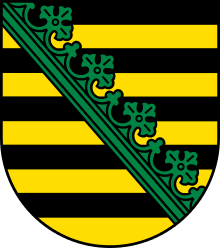House of Saxe-Coburg and Gotha
| House of Saxe-Coburg and Gotha | |
|---|---|
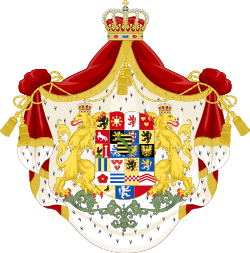 | |
| Parent house | House of Wettin |
| Country | |
| Ethnicity | German |
| Founded | 1826 |
| Founder | Ernest I, Duke of Saxe-Coburg and Gotha |
| Current head | Andreas, Prince of Saxe-Coburg and Gotha |
| Titles |
|
| Estate(s) | Saxe-Coburg and Gotha, Belgium, Portugal, Bulgaria, United Kingdom |
| Deposition | 1918 (in Saxe-Coburg and Gotha) |
| Cadet branches |
|
| Ducal Family of Saxe-Coburg and Gotha |
|---|
 |
|
HH The Prince
HH Princess Gertrud
|
|
Extended family HH Princess Felicitas, Mrs. Trotzky
|
The House of Saxe-Coburg and Gotha (/ˌsæks
Founded by Ernest Anton, the sixth duke of Saxe-Coburg-Saalfeld, it has been the royal house of several European monarchies. Agnatic branches currently reign in Belgium through the descendants of Leopold I and in the United Kingdom and the other Commonwealth realms through the descendants of Prince Albert. Due to anti-German sentiment in the United Kingdom during World War I, George V changed the name of his branch from "Saxe-Coburg and Gotha" to "Windsor" in 1917.[2] The same happened in 1920 in Belgium, where the name was changed to "van België" (Dutch) or "de Belgique" (French) or "von Belgien" (German), meaning "of Belgium".
History
The first duke of Saxe-Coburg and Gotha was Ernest I, who reigned from 1826 until his death in 1844. He had previously been Duke of Saxe-Coburg-Saalfeld (as Ernest III) from 1806 until the duchy was reorganized in 1826. Ernest's younger brother became King of the Belgians in 1831, and his descendants continue to serve as Belgian heads of state. Léopold's only daughter, Princess Charlotte of Belgium, was the consort of Maximilian I of Mexico, and she was known as Empress Carlota of Mexico in the 1860s. Ernest I's second son, Prince Albert (1819–1861), married Queen Victoria in 1840, and thus is the progenitor of the United Kingdom's current royal family, called Windsor since 1917.
In 1826, a cadet branch of the house inherited the Hungarian princely estate of the Koháry family, and converted to Roman Catholicism. Its members managed to marry a queen-regnant of Portugal, an imperial princess of Brazil, an archduchess of Austria, a French royal princess, a royal princess of Belgium and a royal princess of Saxony. A scion of this branch, also named Ferdinand, became ruling Prince, and then Tsar, of Bulgaria, and his descendants continued to reign there until 1946. The current head of the House of Bulgaria, the former Tsar Simeon II, who was deposed and exiled after World War II, goes by the name of Simeon Sakskoburggotski and served as Bulgaria's prime minister from 2001 to 2005.
The ducal house consisted of all male-line descendants of John Ernest IV, Duke of Saxe-Coburg-Saalfeld legitimately born of an equal marriage, males and females (the latter until their marriage), their wives in equal and authorised marriages, and their widows until remarriage. According to the House law of the Duchy of Saxe-Coburg and Gotha, the full title of the Duke was:
Wir, Ernst, Herzog zu Sachsen-Coburg und Gotha, Jülich, Cleve und Berg, auch Engern und Westphalen, Landgraf in Thüringen, Markgraf zu Meißen, gefürsteter Graf zu Henneberg, Graf zu der Mark und Ravensberg, Herr zu Ravenstein und Tonna usw.
We, Ernst, Duke of Saxe-Coburg and Gotha, Jülich, Cleves and Berg, also Angria and Westphalia, Landgrave in Thuringia, Margrave of Meissen, Princely Count of Henneberg, Count of the Mark and Ravensberg, Lord of Ravenstein and Tonna, et cetera.
There were two official residences, in Gotha and Coburg. Therefore, the whole ducal court, including the court theatre, had to move twice a year: from Gotha to Coburg for the summer and from Coburg to Gotha for the winter.[3] For the Court Theater, two almost identical buildings had to be built in 1840 in Gotha (destroyed in the Second World War) and Coburg (now the Coburg State Theater) and thereafter maintained at the same time. In addition to the residential castles, Friedenstein in Gotha and Ehrenburg in Coburg, the ducal family also used the Schloss Reinhardsbrunn in Gotha, as well as the Rosenau and Callenberg Castles in Coburg, and a hunting lodge (Greinburg Castle) in Grein, Austria.
Branches
Ducal branch
Dukes, 1826–1918
- Ernest I 1826–1844
- Ernest II 1844–1893
- Alfred 1893–1900
- Charles Edward 1900–1918
Heads of the house since 1918
- Charles Edward 1918–1954
- Friedrich Josias 1954–1998
- Andreas 1998–present
Although the ducal branch is eponymous with the dynasty, its head is not the senior member of the family genealogically or agnatic. In 1893, the reigning duke Ernest II died childless, whereupon the throne would have devolved, by male primogeniture, upon the descendants of his brother Prince Albert. However, as heirs to the British throne, Albert's descendants consented and the law of the duchy ratified that the ducal throne would not be inherited by the British monarch or heir apparent. Therefore, the German duchy became a secundogeniture, hereditary among the younger princes of the British royal family who belonged to the House of Wettin, and their male-line descendants.
Instead of Albert Edward, Prince of Wales (the future Edward VII of the United Kingdom) inheriting the duchy, it was diverted to his next brother, Prince Alfred, Duke of Edinburgh. Upon the latter's death without surviving sons, it went to the youngest grandson of Prince Albert and Queen Victoria, Prince Charles Edward, Duke of Albany. Charles Edward's uncle Prince Arthur, Duke of Connaught and his male line had renounced their claim. Although senior by birth, they were either not acceptable to the German Emperor as either a member of the British military or unwilling to move to Germany.
The current head of the ducal branch is Andreas, the grandson of Charles Edward. Since the duchy was abolished in 1918, the heads use the title Prince rather than Duke.
 Coat of arms of the duchy of Saxe-Coburg and Gotha
Coat of arms of the duchy of Saxe-Coburg and Gotha Heraldic shield of Saxe-Coburg and Gotha
Heraldic shield of Saxe-Coburg and Gotha- Personal arms of the family since the reign of Charles Edward [4]
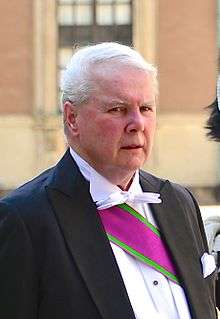 Andreas, Prince of Saxe-Coburg and Gotha (b. 1943), head of the ducal branch
Andreas, Prince of Saxe-Coburg and Gotha (b. 1943), head of the ducal branch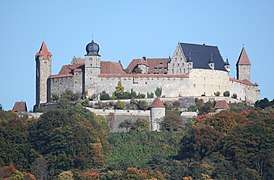 Veste Coburg, ancestral seat of the House of Saxe-Coburg
Veste Coburg, ancestral seat of the House of Saxe-Coburg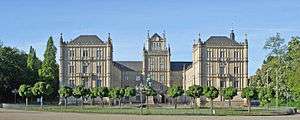 Ehrenburg Palace, Coburg (summer residence)
Ehrenburg Palace, Coburg (summer residence) Friedenstein Castle, Gotha (winter residence)
Friedenstein Castle, Gotha (winter residence)- Reinhardsbrunn Castle, Gotha
 Rosenau Castle, Coburg
Rosenau Castle, Coburg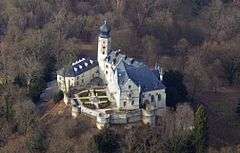 Callenberg Castle, Coburg
Callenberg Castle, Coburg Greinburg Castle, Grein, Austria
Greinburg Castle, Grein, Austria
House of Saxe-Coburg and Gotha-Koháry
The House of Saxe-Coburg and Gotha-Koháry is a Catholic cadet branch of the House of Saxe-Coburg and Gotha. It was founded with the marriage of Prince Ferdinand of Saxe-Coburg and Gotha, second son of Francis, Duke of Saxe-Coburg-Saalfeld, with Princess Maria Antonia Koháry de Csábrág. Their second son Prince August inherited the estates of the House of Koháry in Hungary and Austria. August's youngest son became Ferdinand I of Bulgaria.
- Palais Coburg in Vienna, today a hotel
- Palace of Svätý Anton in Slovakia, today a museum
- Ebenthal, Lower Austria, today private property
 Walterskirchen castle near Poysdorf, Lower Austria is still owned by the family
Walterskirchen castle near Poysdorf, Lower Austria is still owned by the family Edelény Palace, acquired 1831, today owned by the Hungarian state
Edelény Palace, acquired 1831, today owned by the Hungarian state
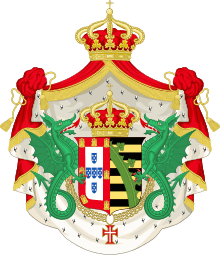
Kingdom of Portugal
The Portuguese line was founded by Prince Ferdinand's eldest son, Ferdinand the younger, who married Queen Maria II of the House of Braganza and became king himself. It was overthrown in the Revolution of 1910, after which it became extinct in 1932 upon the death of Manuel II. Duarte Nuno of Braganza and his successors were descendants of the banished Miguelist line.
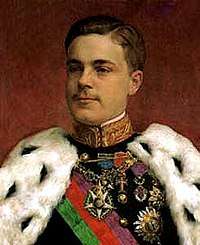 King Manuel II (r. 1908–1910, d.1932)
King Manuel II (r. 1908–1910, d.1932)
.svg.png)
Kingdom of Bulgaria
- Ferdinand I (1887–1918)
- Boris III (1918–1943)
- Simeon II (1943–1946) In 2001, elected[5] Prime Minister of Bulgaria as Simeon Saxe-Coburg-Gotha—also known as Simeon "Sakskoburggotski" (Сакскобургготски).[6][7][8]
 King Simeon II of Bulgaria (r. 1943–1946)
King Simeon II of Bulgaria (r. 1943–1946)
.svg.png)
Kings of the Belgians
The Belgian line was founded by Leopold, youngest son of Francis, Duke of Saxe-Coburg-Saalfeld.
- Leopold I (1831–1865)
- Leopold II (1865–1909)
- Albert I (1909–1934)
- Leopold III (1934–1951)
- Baudouin (1951–1993)
- Albert II (1993–2013)
- Philippe (2013–present)
Belgian royal house
Because of the First World War, the family name was changed in 1920 to van België, de Belgique or von Belgien ("of Belgium") in the country's three official languages (Dutch, French and German). This family name is used on the identity cards and in all official documents. The armorial bearings of Saxony were removed from the Belgian royal coat of arms (see here). The branch of the family that ruled in the United Kingdom of Great Britain and Ireland also discarded their Coburg and Saxon titles and changed their name. Britain's King George V adopted the family name of Windsor, after the Royal Family's place of residence.[9]
.svg.png)
United Kingdom
The British line was founded by King Edward VII, eldest son of Queen Victoria and Prince Albert of Saxe-Coburg and Gotha.
- Edward VII (1901–1910)
- George V (1910–1936; in 1917, the name was changed and the royal house and family became known as Windsor)
From the time of King Edward VII, who reigned from 1901 to 1910, until 1917, when King George V replaced the German-sounding title with the name of Windsor during the First World War, British monarchs officially belonged to the House of Saxe-Coburg and Gotha.
The name Saxe-Coburg-Gotha survived in the Belgian royal family until 1920, and it still survives in the Bulgarian royal family.[10]
Genealogy
Patrilineality, descent as reckoned from father to son, had historically been the principle determining membership in reigning families until late in the 20th century, thus the dynasty to which the monarchs of the House of Saxe-Coburg-Gotha belonged genealogically throughout the 1900s is the House of Wettin, despite the official use of varying names by different branches of the patriline.
References
- ↑ Jones, Daniel (2003) [1917], Peter Roach, James Hartmann and Jane Setter, eds., English Pronouncing Dictionary, Cambridge: Cambridge University Press, ISBN 3-12-539683-2
- ↑ "The House of Windsor – A Proclamation 1917 - British Monarchist Society and Foundation". bmsf.org.uk.
- ↑ Janet Robinson and Joe Robinson, Handbook of Imperial Germany (Bloomington, Indiana: AuthorHouse, 2009), page 87
- ↑ "Homepage". www.sachsen-coburg-gotha.de.
- ↑ Bulgaria: Timeline, BBC News Online, 27 June 2007. Retrieved on 28 July 2007.
- ↑ Former king marks first year as Bulgarian Prime Minister Archived 18 June 2008 at the Wayback Machine., Radio Free Europe, 26 July 2002. Retrieved on 28 July 2007.
- ↑ Bulgarian (or Spanish) Prime Minister? Archived 14 February 2009 at the Wayback Machine., Bulgaria Development Gateway, 24 July 2003. Retrieved on 28 July 2007.
- ↑ Lord Alderdice speaking in the House of Lords on 19 May 2005, Hansard. Retrieved on 28 July 2007.
- ↑ Balfoort, Brigitte; et al. "journalist" (pdf). The Belgian Monarchy. Olivier Alsteens, Director-General of the FPS Chancellery of the Prime Minister, Wetstraat 16, 1000 Brussels. Retrieved 18 July 2012.
- ↑ Saxe-Coburg-Gotha on the official website of the British monarchy
External links
| Wikimedia Commons has media related to House of Saxe-Coburg and Gotha. |
- Official Website of the Ducal House of Saxe-Coburg and Gotha
- Callenberg Castle website
- European Heraldry page
House of Saxe-Coburg and Gotha Cadet branch of the House of Wettin | ||
| New title | Ruling house of the Duchy of Saxe-Coburg and Gotha 1826–1918 |
Duchy Abolished |
| Ruling house of the Kingdom of Belgium 1831–present |
Incumbent | |
| Preceded by House of Braganza |
Ruling house of the Kingdom of Portugal (Ruled under the name House of Braganza) 1853–1910 |
Monarchy Abolished |
| Preceded by House of Battenberg |
Ruling house of the Kingdom of Bulgaria 1887–1946 | |
| Preceded by House of Hanover |
Ruling house of the United Kingdom (Renamed House of Windsor by Royal Proclamation of 17 July 1917) 1901–1917 |
Succeeded by House of Windsor |
